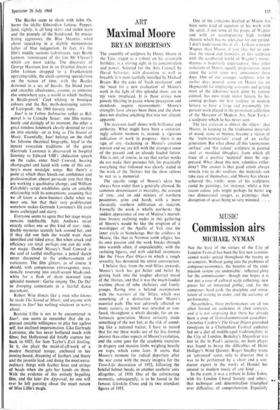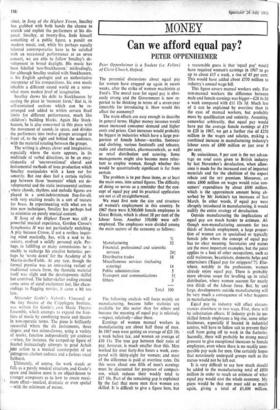Commission airs MUSIC
MICHAEL NYMAN
Not the least of the virtues of the City of London Festival has been the five new commis- sioned works spread throughout the twenty or so concerts. Without going into the problems of composer-economics, the benefits of the com- mission system arc undeniable: reflected glory for the commissioner—though one hopes it is not just a case of cultural scalp collecting; new pieces for an interested public; and, for the composer, hard cash, the discipline and stimu- lation of writing to order, and the certainty of performance.
Nevertheless, these performances arc all too often foisted on audiences in alien contexts, and it is not surprising that there has already been a crop of festival-commission casualties: Cornelius Cardew's The Great Digest provoked rowdyism in a Cheltenham Festival audience fed on a diet of middle-aged traditionalists; at the City of London, Berkeley's Magnificat was lost in the St Paul's acoustic; no horn player was found to brave the difficulties of Heinz Holliger's Wind Quintet; Roger Smalley wrote an `advanced' score, only to discover that it was to be performed by a choir and a con- ductor expert in the works of Handel but unused to modern music of any kind . . .
In the event, it was a tribute to John Tobin, with his London Choral Society and others, that technique and determination triumphed over difficulties of comprehension. Especially
since, in Song of the Highest Tower, Smalley has grabbed with both hands the chance to stretch and exploit the performers at his dis- posal. Smalley, at twenty-five, finds himself something of a public figure, a pundit on modern music, and, while his perhaps equally talented contemporaries have to be satisfied • with an occasional performance at an SPNM concert, we are able to follow Smalley's de- velopment in broad daylight. His music has been labelled `neo-Stockhausen,' misleadingly, for although Smalley studied with Stockhausen, is his English apologist and an authoritative interpreter of his compositions, his own music inhabits a different sound world on a some- what more modest level of imagination.
Smalley shows his debt to Stockhausen by casting the piece in `moment form,' that is, in self-contained sections which can be re- arranged and added to within certain fixed limits for different performance, much like children's building blocks. Again like Stock- hausen, he is also concerned in this piece with the movement of sounds in space, and divides the performers into twelve groups arranged in , front of, to the right and behind the audience, with the material rotating between the groups.
The writing is always clever and imaginative, especially where the score appears, in its multitude of verbal directions, to be an ency- clopaedia of `unconventional' choral and instrumental methods of tone production which Smalley manipulates with a keen ear for sonority. But one does feel a certain stylistic gap between those 'moments' which are de- velopmental and the static instrumental sections where chords, rhythms and melodic figures are played in a semi-indeterminate free-for-all, with very exciting results in a sort of toccata for brass. In experimenting with what are to him new techniques, Smalley has perhaps had to minimise on purely musical content.
If Song of the Highest Tower was still a powerful musical experience, Gordon Crosse's Symphonies II was not particularly enriching.
A pity because Crosse, if not a restless inquir- ing mind musically, has, with a nod to his seniors, evolved a mildly personal style. Per- haps in fulfilling so many commissions he is unable to recharge his creative batteries; per- haps he `wrote down' for the Academy of St Martin-in-the-Fields. At any rate, though the formal premise was an interesting variant of traditional sonata form, the thematic material itself was slight and the developments skilful but contrived. The helter-skelter ending created some sense of aural excitement but, like chase- endings to flagging movies, it came a bit too late.
Alexander Goehr's Naboth's Vineyard, at the tiny theatre of the Cripplegate Institute, was written for Goehr's own Music Theatre Ensemble, which attempts to expand the fron- tiers of music by combining music and theatre in non-operatic terms. The piece is brilliantly successful where the six instruments, three singers and two mime-clowns, using a variety of masks, function independently yet coalesce —when, for instance, the camped-up figure of Jezebel insinuatingly attempts to goad Achab j.nto action to a musical counterpoint of an gutrageous clarinet cadenza and a furious vocal Zutburst.
Ultimately, of course, the work stands or falls as a purely musical structure, and Goehr's spare and incisive score is an object-lesson to younger composers as to how to create maxi- mum effect—musical, dramatic or even spatial —with the minimum of means.







































 Previous page
Previous page